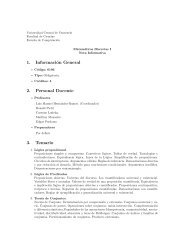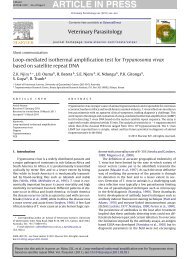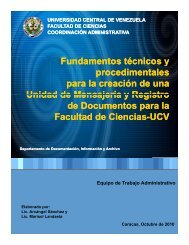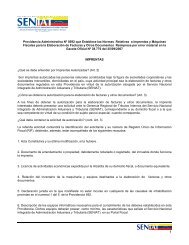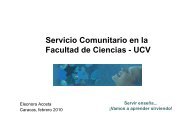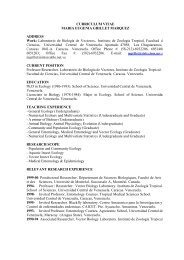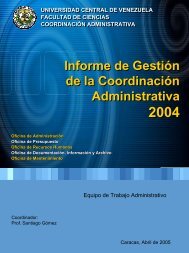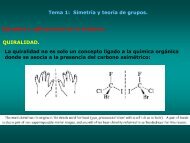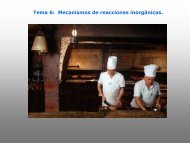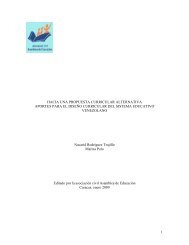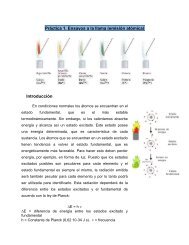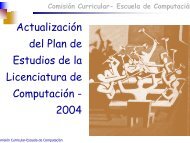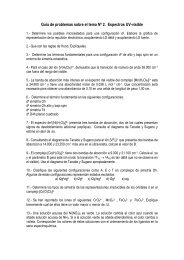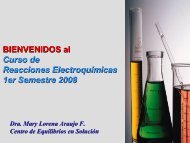Collecting and Preserving
Collecting and Preserving
Collecting and Preserving
- No tags were found...
Create successful ePaper yourself
Turn your PDF publications into a flip-book with our unique Google optimized e-Paper software.
ReferencesA’Brook, J. 1973. Observations on different methods ofaphid trapping. Ann. Appl. Biol. 74:263-267.Acree, F., <strong>and</strong> others. 1968. L-lactic acid: A mosquitoattractant isolated from humans. Science (Wash.,D.C.) 161:1346-1347.Acuff, V. R. 1976. Trap biases influencing mosquitocollecting. Mosq. News 36:173-196.Adkins, T. R. 1972. A modified canopy trap for collectingTabanidae (Diptera). J. Med. Entomol. 9:183-195.Adlerz, W. C. 1971. A reservoir-equipped Moericke trapfor collecting aphids. J. Econ. Entomol. 64:966-967.Akar, H. <strong>and</strong> E.A. Osgood. 1987. Emergence trap <strong>and</strong>collecting apparatus for capture of insects emergingfrom soil. Ent. News 98(1): 35-39.Alm<strong>and</strong>, L. K., <strong>and</strong> others. 1974. A collapsible truckmountedaerial net for insect sampling. Tex. Agr. Exp.Stn. Misc. Publ. 1189:1-4.Andreyev, S. V., <strong>and</strong> others. 1970. Electric light traps inresearch on the protection of plants against insectpests. Entomol. Rev. 49:290-297.Apperson, C. S., <strong>and</strong> D. G. Yows. 1976. A light trap forcollecting aquatic organisms. Mosq. News 36:205-206.Arnett, R. H. 1985. American insects. 850 pp. VanNostr<strong>and</strong> Reinhold, New York.Atkins, M. D. 1957. An interesting attractant for Priacmaserrata (LeC.) (Cupesidae: Coleoptera). Can.Entomol. 89:214-219.Azrang, M. 1976. A simple device for collecting insects.Entomol. Tidskr. 97:92-94.Baker, J. R. 1958. Principles of biological microtechnique.357 pp. Methuen, London; John Wiley, NewYork.Balogh, J. 1958. Lebensgemeinschaften der L<strong>and</strong>tiere;ihre Erforschung unter besonderer Berücksichtigungder zoozonologischen Arbeitsmethoden. 560 pp.Verlag Ungar. Akad. Wiss., Budapest; Akad. Verlag,Berlin. [In German.] An extensive compilation, with27 pp. of references.Banks, C. J. 1959. Experiments with suction traps toassess the abundance of Syrphidae (Diptera), withspecial reference to the aphidophagous species.Entomol. Exp. Appl. 2:110-124.Banks, N. 1909. Directions for preserving <strong>and</strong> collectinginsects. U.S. Natl. Mus. Bull. 67, 135 pp. Mostly ofhistorical interest, but describes well the old methods<strong>and</strong> contains much general information about insects.Banks, W. A., <strong>and</strong> others. 1981. Techniques for collecting,rearing, <strong>and</strong> h<strong>and</strong>ling imported fire ants. U.S.Dept. Agr., Agr. Res. Serv., AAT-S-21, 9 pp.Barber, H. S. 1931. Traps for cave-inhabiting insects. J.Elisha Mitchell Sci. Soc. 46:259-266, pl. 23.Barber, M. C., <strong>and</strong> R. W. Matthews. 1979. Utilization oftrap nests by the pipe-organ muddauber, TrypargilumTechniques <strong>and</strong> Toolspolitum (Hymenoptera: Sphecidae). Ann. Entomol.Soc. Am. 72:258-262.Barnard, D. R. 1979. A vehicle-mounted insect trap. Can.Entomol. 111:851-854.__________ <strong>and</strong> M. S. Mulla. 1977. A non-attractivesampling device for collection of adult mosquitoes.Mosq. News 37:142-144.Barnes, H. F. 1941. Sampling for leather jackets withorthodichlorobenzene emulsion. Ann. Appl. Biol.28:23-28.Barnes, R. D. 1974. Invertebrate zoology. Ed. 3, 870 pp.W. B. Saunders, Philadelphia.Barr, A. R., <strong>and</strong> others. 1963. Evaluation of some factorsaffecting the efficiency of light traps in collectingmosquitoes. J. Econ. Entomol. 56:123-127.Barrett, J. R., Jr., H. O. Deay, <strong>and</strong> J. G. Hartsock. 1971.Striped <strong>and</strong> spotted cucumber beetle response toelectric light traps. J. Econ. Entomol. 64:413-416.Barrowclough, G. F. 1992. Systematics, biodiversity, <strong>and</strong>conservation biology. pp. 121-143. In, N. Eldredge ed.Systematics, ecology, <strong>and</strong> the biodiversity crisis.Columbia University Press, New York. 220pp.Bartnett, R. E., <strong>and</strong> R. G. Stephenson. 1968. Effect ofmechanical barrier mesh size on light trap collectionin Harris County, Texas. Mosq. News 28:108.Batiste, W. C., <strong>and</strong> W. Joos. 1972. Codling moth: A newpheromone trap. J. Econ. Entomol. 65:1741-1742.Beatty, G. H., <strong>and</strong> A. F. Beatty. 1963. Efficiency in caringfor large Odonata collections. Proc. N.C. BranchEntomol. Soc. Am. 18:149-153.Beaudry, J. R. 1954. A simplification of Hubbell's methodfor trapping <strong>and</strong> preserving specimens ofCeuthophilus (Orthoptera, Gryllacrididae). Can.Entomol. 86:121-122.Beavers, J. B., <strong>and</strong> others. 1972. Synthetic attractants forsome dipteran species. J. Econ. Entomol. 65:1740-1741.Belkin, J. N. 1962. The mosquitoes of the South Pacific(Diptera Culicidae). 2 v. Univ. Calif. Press, Berkeley.V. 1 includes introduction on methods.Bellamy, R. E., <strong>and</strong> W. C. Reeves.1952. A portablemosquito bait trap. Mosq. News 12:256-258.Belton, P. 1962. Effects of sound on insect behavior. Proc.Entomol. Soc. Manitoba 18:22-30.__________ <strong>and</strong> R. H. Kempster. 1963. Some factorsaffecting the catches of Lepidoptera in light traps.Can. Entomol. 95:832-837.__________ <strong>and</strong> A. Pucat. 1967. A comparison ofdifferent lights in traps for Culicoides (Diptera:Ceratopogonidae). Can. Entomol. 99:267-272.Beroza, M. 1970. Current usage <strong>and</strong> some recent developmentswith insect attractants <strong>and</strong> repellents in theUSDA. In Beroza, M., ed., Chemicals controllinginsect behavior, pp. 145-163. Academic Press, NewYork.__________ 1972. Attractants <strong>and</strong> repellents for insectcontrol. In Pest control: Strategies for the future, pp.53



